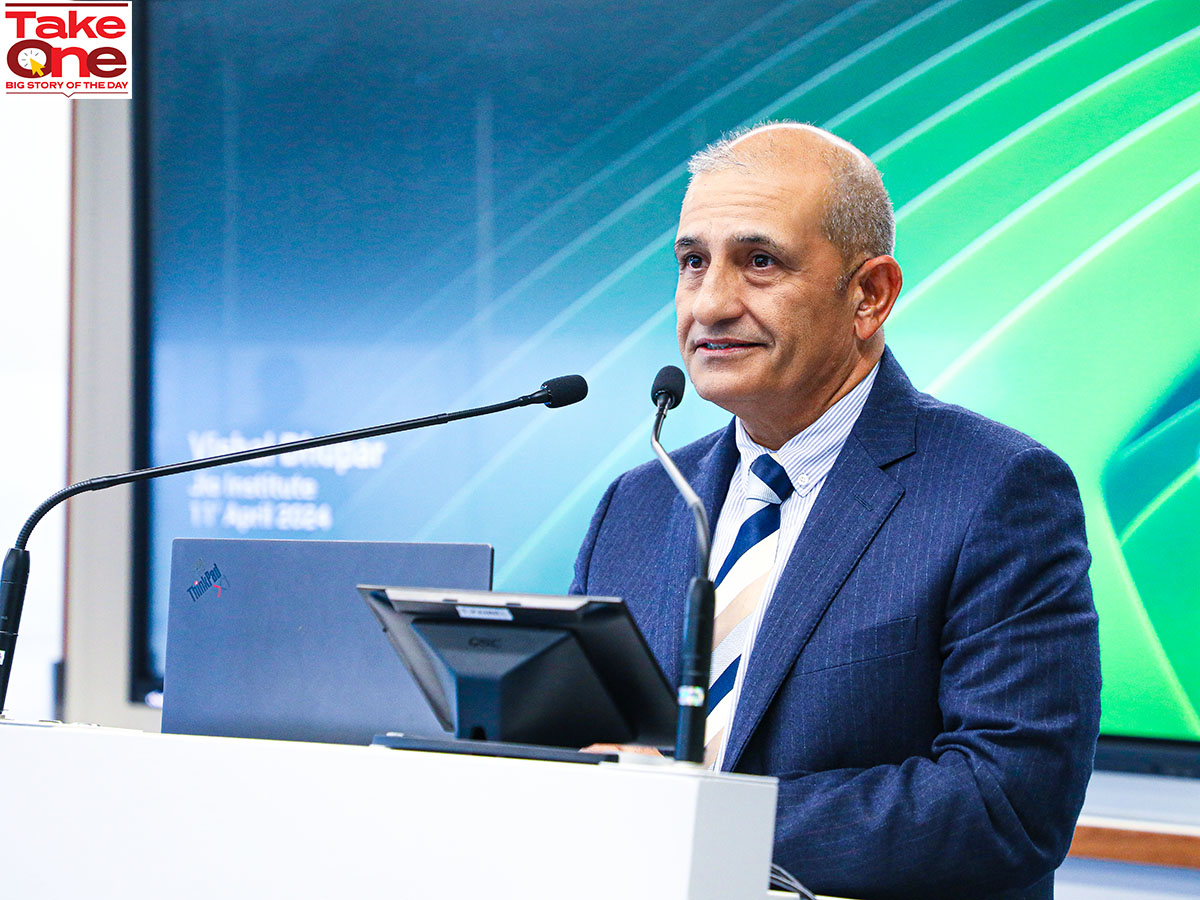It's time for India to become the world's front office: Nvidia's Vishal Dhupar
The managing director in South Asia decodes Nvidia's market strategy for India, how the country can control its own data, building India's sovereign AI, and more
 Vishal Dhupar, MD, NVIDIA
Vishal Dhupar, MD, NVIDIA
Nvidia faced a brief but brutal selloff in early September after announcing its latest quarterly results. The trigger was also from the Department of Justice in the US investigating antitrust regulations concerning the artificial intelligence chip company. Nvidia promptly denied the report. The shares surged after CEO Jensen Huang asserted that the chipmaker is experiencing an incredible demand.
Currently, Nvidia commands about 90 percent share of the artificial intelligence (AI) chip market, giving a run to its competitors Advanced Micro Devices (AMD) and Intel. It’s worth noting only a few companies are fuelling their AI chip business. On the strength of four customers—whose identities the company does not disclose for competitive reasons—Nvidia more than doubled its second-quarter revenue. These four customers purchased goods and services collectively worth 46 percent of Nvidia’s $30 billion in turnover. They are likely to be Amazon, Google, Meta, and Microsoft.
Meanwhile, back in India where it set up base two decades ago, Nvidia’s operations have more than tripled its revenues since FY18, as per VCCEdge, a data research platform. With four engineering centres in Bengaluru, Hyderabad, Pune, and Gurugram, the 4,000 engineers employed make it Nvidia’s second-largest talent pool after the United States. In addition, its developer program in India has over 320,000 developers and about 60,000 CUDA (Compute Unified Device Architecture) developers.
The country's talent pool prompted Nvidia to launch its operations in Bengaluru. The company wanted India to contribute to the highest end of the value chain. The idea was to not only make the processor but also build adjoining software stacks into it, says Vishal Dhupar, who has been heading India business since 2010 and serving as the managing director in South Asia. Therefore, the comprehension in India was to build a talent that could do hardware and software and, more importantly, use the benefits of multiple PhDs who understand computational science.
During Nvidia’s developer conference in March, Huang said he sees India as a key player in the future of AI. He highlighted the country’s large pool of IT professionals is perfectly positioned to reskill and enable India to be the front office of the AI revolution.
The tech giant is also sealing deals with Tata, Reliance, and Infosys and is in talks with the Indian government to supply GPUs. Nvidia will deliver AI computing infrastructure and platforms for developing AI solutions like creating large language models (LLMs) in Indian languages, building GPU cloud infrastructures, and helping India build its sovereign AI.
In an exclusive interaction with Forbes India, Dhupar sheds light on advancing India from the back office of the world to being the office of the world, Nvidia’s market strategy for India, enabling the country to control its own data, and more.
Nvidia GPUs in India
A computer used to be a node, like personal computers and mobile phones, and these are simple nodes that serve a purpose. But to teach computers to learn and produce intelligence, a data centre is needed that becomes a single compute node. “The important part was for someone to start that journey in India. When we started talking to different business houses, multiple people stepped up. Yotta was the first mover. They brought it into the country, and the good part is that it's operational and accessible for people to use it,” says Dhupar.Hiranandani-backed Yotta became the first Indian company to acquire AI chips from Nvidia in March. During his India visit in September last year, Huang met Prime Minister Narendra Modi and ensured high priority allocation to India. Huang said the country is going to be the largest AI market in the world, and he would prioritise any orders from data centre operators in the country. Five-year-old Yotta placed an order for 16,000 H100 chips, including the newly announced Blackwell AI-training GPU. The first batch of 4,000 chips arrived in March, comprising Nvidia H100 Tensor Core GPUs. The Mumbai-based venture is offering managed cloud services along with the ability for enterprises to use Yotta’s cloud for training LLMs and building applications like OpenAI’s ChatGPT.
Also read: Will Nvidia's AI gold rush continue?
Sarvam AI: India’s Answer to OpenAI
Sarvam is one of the AI startups that has access to Yotta’s H100 processors. In August, the Bengaluru-based startup launched a host of products for enterprise usage and open source as part of its full-stack generative AI platform. Founded in 2023, the Lightspeed and Peak XV-backed Sarvam launched five products that will perform various tasks, like SarvamAgents, which will offer multilingual voice-enabled agents that will be able to talk to customers over a phone call, WhatsApp, or in-app chat. Sarvam has partnered with Yotta, Nvidia, Microsoft Azure, Google Cloud Platform (GCP), and Exotel for these services and products. The Sarvam stack is powered by Nvidia's H100 chips. While Azure, GCP, and Yotta will act as the company’s cloud partners, Exotel will power Sarvam’s chatbot for its customer conversations.A lot of people who have good ideas but have been constrained due to a lack of infrastructure will now leapfrog, explains Dhupar. Everything seems to be falling into place, giving confidence both to India and an ability for India to really start off to the next level. India's advantage is that we are the back office of the world. “Everybody comes here to hire skilled people. Now, along with that, if we buy skilled computing nodes, the combination of will leapfrog us to being the office of the world, not just the back office of the world.”
Building Sovereign AI for India
In 2018, when the country was writing the strategy paper ‘AI for All’, they were looking at challenges in education, health care, and urban mobility, among others. They believed that the country now stands at a brink that we don't need to follow, but we can actually lead with 1.4 billion people speaking in multiple languages and having different contexts. “The idea is to utilise the wealth of information within our boundaries rather than bring it back as an import,” says Dhupar. The underlying requirement is building infrastructure, which the world cannot operate without.The country is finally taking a step forward in building an accelerated computing foundation. This is an opportunity for young entrepreneurs to advance their ideas and a chance for big Indian businesses to disrupt their models. “We have the skills, domain experience, and a divided society.” Not everyone in India has access to computers; the majority of them only have a smartphone. “It's about the democratisation of technology, which is upon us, and hence this initiative is crucial.”
Market strategy for India
“We're helping, working with all the providers of technology to bring in the infrastructure and the platform. The question of economics is a question of people who are basically participating in doing it. If you paid attention to what Sarvam AI did, there's a reason why he made that announcement,” said Dhupar, adding that everybody understands that when you are doing things at the population scale of India, you do it in different parameters, and that's why ecosystems become important.In May, the Indian government announced plans to procure 10,000 GPUs within the next 18 months to enhance computational capabilities and create an AI marketplace. The government will spend up to 50 percent of the cost likely to be incurred under the National Artificial Intelligence (AI) mission. It plans to partner with private companies such as Nvidia to source GPUs from them and offer them to Indian startups, academics, and researchers at a subsidised rate.
The GPU demand in India is going to be driven by two key applications: 1) high performance computing (HPC), which is supercomputing applications in research, and 2) advanced Gen AI-based training and inferencing via cloud hyperscalers, data centres, and enterprises, explains Neil Shah, vice president of research at Counterpoint Research.
In the last week of August, a pre-bid meeting was held by the government where tech companies, including Nvidia, Intel, AMD, Qualcomm, Microsoft Azure, Amazon Web Services (AWS), Google Cloud, and Palo Alto Networks, showed interest in the Indian government's Rs10,000 crore tender for procuring graphics processing units.
“India should take lead as the new industrial revolution is upon us. Several cities in our country could be the intelligence capital of the world, and I believe everything that is happening is a possibility towards that,” says Dhupar.


















